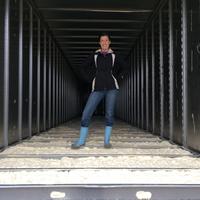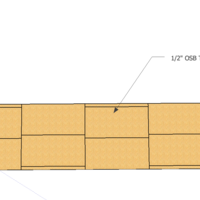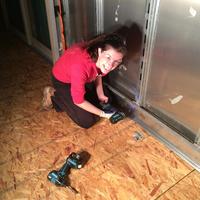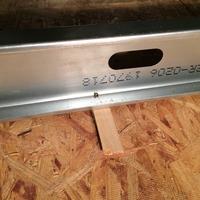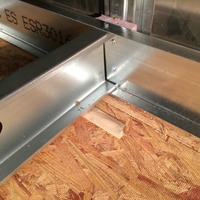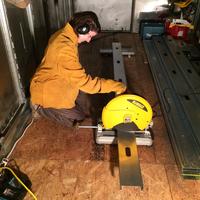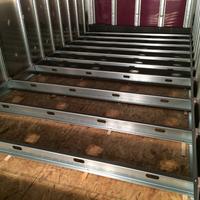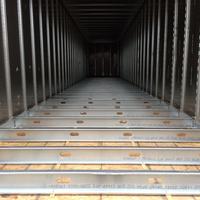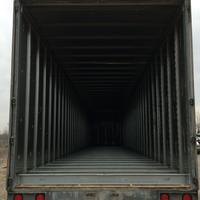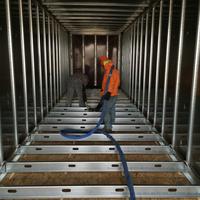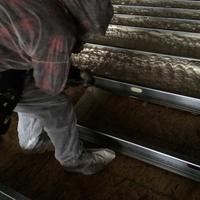Floor Framing and Insulation
Where to start?
Again we're back to design premises. We made a few general choices with the build:
- We would frame and insulate the floor, walls, and ceiling. We are expecting this to be our full time residence for five to ten years. We live in the midwest, and want to be able to travel to Canada or Alaska if we choose. Also, we want heating and cooling to be as effecient as possible and decided that the up front investment will be worth it.
- All of our utilities will be inside the framed and insulated section of the trailer. This keeps us from having to worry about external water lines and tanks from freezing, etc. This also meant no conduit in the floor, so the punch outs didn't need to line up.
- Framing of the walls will be completely necessary to support windows and doors. A stretch goal is to provide enough framing to stiffen the roof to allow for people to walk on it safely (also to provide more support in case of a lot of snow).
- How much insulation would we need? I followed the guides from the US Department of Energy: http://energy.gov/energysaver/articles/tips-insulation. For Ohio, this is Zone 5 and that's a lot of insulation.
- I chose to use steel studs and track for the framing in stead of wood. Although six inch, eighteen gauge, track and studs are more expensive than 2x6 wood framing, I felt that I would end up with a much better structure when I was complete. Also, I have never used those materials before, and I liked certain features such as pre-punched holes for conduit/plumbing.
- To get enough insulation (even with closed cell spray foam) I would need at least 4 inches of insulation on the floor and ceiling. I went with six inch, 18 gauge, studs and track after discussing with my supplier. First, it turned out that six inch was no more expensive than 4 inches or 5.5 inches (even though you ended up with more metal). Also, 18 gauge is where the manufacturers start calling the material "structural".
- Installation of steel studs will probably be easier as the trailer already had steel stifners attached to the aluminum skin at perfect 16 inch and 24 inch centers (16 inch for the first 7, then 24 inch after that). All I had to do was line everything up with the stiffners and screw it in. If I went with wood, although the floor framing wouldn't be a problem, I wouldn't be able to attach the studs to the stiffners easily without brackets, etc.
- I would use closed cell spray foam. Yes, it's the most expensive option, but there are some really great benefits. For one, it expands and fills in all of the cracks, and is way more effecient per inch than anything else. It's also a moisture barrier, this is huge for me. Even though the trailer is (mostly) water tight. It's nice to know that I have extra protection because the foam will plug up all of the tiny cracks that are formed or will form.
Thermal Break
When I started this project, I had never heard this term. Bascially it boils down to this: when metal is used for structual portions of a building, you must provide a non-conductive material break between the metal and the outside. This prevents the metal structure from conducting the heat/cool around that expensive insulation that you install. I found a great write on the interwebs: THERMAL BREAKS AND STEEL FRAMING - Branz. If you don't do it, you basically end up with a very expensive thermal sieve. Not a good way to build for sure. In my project, I have two major places where I did this. The first was on top of the original floor that the trailer came with. Almost all of the trailer's original floor was wood. Unfortunately the front 8 feet or so was metal that was flush with the wood floor. I had to lay down a thermal break on the steel, but decided to go ahead and lay it everywhere. For me, I liked the idea of having a nice, construction ready surface along the entire bottom of the trailer. This turned out to be very fortuitous later in the floor installation. The cost was only a couple hundred dollars in materials and a day or so in installation by my wife and I. The second major thermal break I chose was 3/4" RPS foam between the steel framing and the existing steel stiffners in the trailer. Basically, I will have framing running along all of the existing stiffners, so whenever that happens, I put 3/4" foam in between and screw through it. The general rule for this build is: load bearing thermal break is 1/2" OSB, non-load bearing thermal break is 3/4" RPS foam.
OSB Thermal Break Installation
This part of the project was pretty easy. We laid out the 4'x8' sheets of OSB with 1/8" spacing (10D nail worked perfectly) on top of PL construction adhesive. We then cut 1"-2" strips and placed those as necessary (the width of the inside was about 100", just annoyingly over 8'). You can see the layout in the picture above. The only annoying part was that we had to pre-drill holes in the front 8' section of the trailer where the floor was steel. But that wasn't too bad once we figured out how to do it. Also, I have to point out that we used Torx screws for this part of the project. I personally hate phillips screws, and will avoid them like the plague. I prefer Torx or Square drive in all cases. I think it's always worth the investment.
Floor Track and Joists
There are a few things I should point out here. For one thing, the use of 600S162 and 600T162 is probably not certified by the manufactures to be used as floor joists. The reason I used it here is because normally a floor joist actually has to span something to provide support. But in this case, I was just laying it across an existing floor (that was supported by steel I-beams). Also, it was only just over 8' wide. It also simplified my build as I only had one type of track and stud for the whole project. As for installation, the track went in easily. We just drilled and screwed in two #10 sheet metal screws at each stiffner (with the piece of RPS foam in between). The joists are where things got interesting. Once we laid in a joist, we realized there was a slight gap between the joists and the floor. Also, I couldn't think of a way to get a second sheet metal screw through the track at the bottom of the joist where it met the track. In the end, we shimmed each joist four times and screwed into the thermal break that we had laid (thankfully we laid the whole trailer, and not just the front). This would prevent rotation, as well as create six point of contact with the floor (2 in the track, and 4 with shims). Hopefully spreading the load as evenly as possible into the floor. This part of the installation was arduous at best.
Spray Foam
I found a contactor to come and install closed cell spray foam into the joists that were laid. Why did we do this now? Well, the idea is that we can lay the subfloor next and plumb the furnace to provide heat from now on. Also, the contactor wasn't going to charge me for coming twice. This was the easiest part of the project so far. I called, they came, they sprayed, I paid. Easy! There are a few pictures of before, during, and after foam installation.


